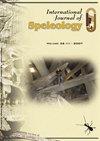Speleothems in quartz-sandstone caves of Ponta Grossa municipality, Campos Gerais region, Paraná state, southern Brazil
IF 1.3
4区 地球科学
Q3 GEOSCIENCES, MULTIDISCIPLINARY
引用次数: 3
Abstract
The present communication characterizes and discusses the genesis of cave speleothems developed in Furnas Formation (Silurian-Devonian) and Vila Velha sub-unit (Campo Mourão Formation, Upper Carboniferous) quartz-sandstones, in southern Brazil. The research, which involved stratigraphic and petrographic studies, was conducted to identify the faciological context of occurrence of these features, and to determine, through different analytical methods, their mineralogical composition and porosity, and also the action of microbial markers on the genesis of these secondary mineral deposits. The speleothems were classified into six types based on form, composition and genesis: (1) arborescent (coral), (2) mushroom-shaped, (3) stalactitic, (4) stalagmitic, (5) columnar with horizontal/ascending growth, and (6) fibrous. In response to substrate permoporosity, speleothems develop on all sandstone facies of the study area, mainly in sites controlled by bedding, stratification and fracturing planes. They are less frequent, however, in conglomerate and silty-clayey layers of the Furnas Formation, being composed mainly of silica (opal-A and cryptocrystalline silica) and kaolinite, with lesser contribution of gypsum and amorphous iron oxides associated with goethite and hematite. Detritic minerals such as quartz and muscovite also take part in the composition of these features. Plant and invertebrate fragments were identified, including biosignatures and microorganisms capable of favoring precipitation of silica (possibly cyanobacteria and diatom) and iron oxide (possibly Gallionella ferruginea). Such biosignatures and extracellular polymeric substances (biofilms) associated with speleothems are evidence of organomineralization, also known as biologically induced mineralization. The results, which indicate biological action on the genesis of speleothems, raise further discussion on the influence of microorganisms on the dissolution and precipitation of silica and kaolinite in the region.巴西南部帕拉纳州坎波斯吉拉斯地区蓬塔格罗萨市石英砂岩洞穴中的洞穴
巴西南部志留纪-泥盆纪furas组和上石炭统Campo mour组Vila Velha亚单元石英砂岩中发育的洞穴洞穴特征及其成因的交流。这项研究包括地层学和岩石学研究,旨在确定这些特征发生的地质背景,并通过不同的分析方法确定它们的矿物组成和孔隙度,以及微生物标志物对这些次生矿床成因的作用。根据其形态、组成和成因,将其划分为6种类型:(1)树状(珊瑚状)、(2)蘑菇状、(3)钟乳状、(4)石笋状、(5)水平/上升生长的柱状、(6)纤维状。研究区各砂岩相均发育洞室,主要发育在受层理、层理和压裂面控制的位置。然而,它们在弗纳斯组的砾岩和粉质粘土层中较少出现,主要由二氧化硅(蛋白石- a和隐晶二氧化硅)和高岭石组成,与针铁矿和赤铁矿相关的石膏和无定形氧化铁的贡献较少。碎屑矿物如石英和白云母也参与了这些特征的组成。鉴定了植物和无脊椎动物的碎片,包括生物特征和能够有利于沉淀二氧化硅(可能是蓝藻和硅藻)和氧化铁(可能是铁Gallionella ferruginea)的微生物。这些生物特征和与洞穴相关的细胞外聚合物质(生物膜)是有机矿化的证据,也称为生物诱导矿化。这些结果表明,微生物对洞穴石的成因有生物作用,并进一步探讨了微生物对该地区二氧化硅和高岭石溶解和沉淀的影响。
本文章由计算机程序翻译,如有差异,请以英文原文为准。
求助全文
约1分钟内获得全文
求助全文
来源期刊

International Journal of Speleology
地学-地球科学综合
CiteScore
3.10
自引率
23.10%
发文量
12
审稿时长
>12 weeks
期刊介绍:
The International Journal of Speleology has the aim to get cave and karst science known to an increasing number of scientists and scholars. The journal therefore offers the opportunity to all scientists working in and on karst to publish their original research articles or their review papers in an open access, high quality peer reviewed scientific journal at no cost. The journal offers the authors online first, open access, a free PDF of their article, and a wide range of abstracting and indexing services.
 求助内容:
求助内容: 应助结果提醒方式:
应助结果提醒方式:


